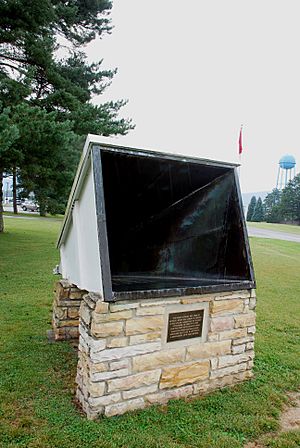Edward Mills Purcell facts for kids
Quick facts for kids
Edward Mills Purcell
|
|
|---|---|

Purcell in 1952
|
|
| Born | August 30, 1912 Taylorville, Illinois, United States
|
| Died | March 7, 1997 (aged 84) Cambridge, Massachusetts, United States
|
| Alma mater | Purdue University (BSEE) Harvard University (M.A.) Harvard University (Ph.D) |
| Known for | Nuclear magnetic resonance spectroscopy 21 cm line Microswimmer Scallop theorem Purcell effect Smith–Purcell effect |
| Awards | Nobel Prize for Physics (1952) Oersted Medal (1967) National Medal of Science (1979) Max Delbruck Prize (1984) Beatrice M. Tinsley Prize (1988) |
| Scientific career | |
| Fields | Physics |
| Institutions | Harvard University MIT |
| Thesis | The Focusing of Charged Particles by a Spherical Condenser (1938) |
| Doctoral advisor | Kenneth Bainbridge |
| Other academic advisors | John Van Vleck |
| Doctoral students |
|
| Other notable students | |

Edward Mills Purcell (born August 30, 1912 – died March 7, 1997) was an American physicist. He is famous for discovering nuclear magnetic resonance (NMR). This discovery helped scientists study the structure of molecules. It also led to the development of magnetic resonance imaging (MRI). MRI is a very important tool in medicine today. Purcell shared the 1952 Nobel Prize for Physics for his work. Friends and colleagues often called him Ed Purcell.
Contents
A Life in Science
Edward Purcell grew up in Taylorville, Illinois. He studied electrical engineering at Purdue University. Later, he earned his master's and Ph.D. degrees in physics from Harvard University.
During World War II, Purcell worked at the MIT Radiation Laboratory. There, he helped develop important microwave radar technology. After the war, he returned to Harvard to continue his research.
Discovering NMR
In December 1946, Purcell and his team, Robert Pound and Henry Torrey, made a huge breakthrough. They discovered nuclear magnetic resonance (NMR). Imagine tiny magnets inside atoms. NMR uses radio waves and strong magnetic fields to "talk" to these atomic magnets. This allows scientists to learn about the chemical makeup of different materials.
NMR became a key tool in physics and chemistry. It helps scientists understand how molecules are built. Even more, it's the basic idea behind magnetic resonance imaging (MRI). MRI lets doctors see inside the human body without surgery. This has saved countless lives and helped many people. For this amazing discovery, Purcell shared the 1952 Nobel Prize in physics with Felix Bloch.
Exploring the Universe
Purcell also made big contributions to astronomy. He was the first to detect radio waves coming from neutral hydrogen gas in our galaxy, the Milky Way. This special radio signal is called the 21 cm line. It's like a unique fingerprint for hydrogen in space.
Detecting this signal was a huge step for radio astronomy. It allowed scientists to map the spiral arms of the Milky Way for the first time. Even today, measuring the 21 cm line is a vital technique for astronomers.
Other Important Work
Purcell also studied solid state physics. This field looks at the properties of solid materials. He explored how tiny particles called spins behave in these materials. His work was important for developing technologies like the laser.
He also wrote a very influential textbook called Electricity and Magnetism. This book was special because it used relativity to explain electricity and magnetism. It helped many students learn these complex topics.
Purcell is also remembered by biologists for a famous lecture. It was called "Life at Low Reynolds Number". In this lecture, he explained how tiny creatures, like bacteria, move in water. He showed that at very small scales, water acts like a thick syrup. He also introduced the Scallop theorem, which explains why some simple swimming motions don't work for tiny organisms.
Awards and Recognition
Edward Purcell received many awards for his scientific work. He also served as a science advisor to three U.S. Presidents: Dwight D. Eisenhower, John F. Kennedy, and Lyndon B. Johnson. He was also the president of the American Physical Society. In 1979, he was awarded the National Medal of Science, one of the highest honors for scientists in the United States.
Edward Purcell passed away on March 7, 1997, in Cambridge, Massachusetts, at the age of 84. His discoveries continue to impact science and medicine today.
See also
 In Spanish: Edward Mills Purcell para niños
In Spanish: Edward Mills Purcell para niños
- Magnetic resonance imaging (MRI)
- Spin echo

